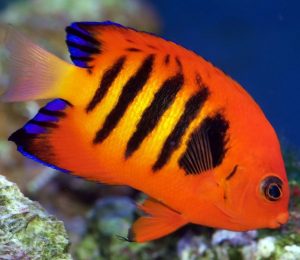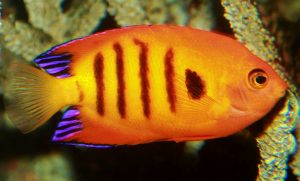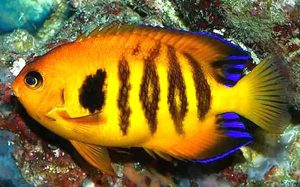The Flame Angelfish (Centropyge loriculus) known to tropical fish keeping enthusiasts as Flame Angel, Flaming Angelfish, Red Angelfish, and Japanese Pygmy Angelfish was first discovered in the Society Islands in the Pacific Ocean. They range throughout Western and Central Pacific waters including Belau, Tahiti, the Hawaiian, Marquesas, Marshall, Christmas, and Ducie Islands, as well as the Great Barrier Reef and Pitcairn group of Islands.
Most tropical fish keeping enthusiasts agree that because of their beauty, hardiness, and relatively non aggressive personality, the Flame Angelfish beyond a doubt the most popular dwarf species for novice and expert aquarists.
In their natural habitat, Flame Angelfish live in small groups of three to seven individuals. They prefer stony coral reefs in clear lagoons where they congregate at depths of 15 to 82 feet along the outer slopes of the reef.
Flame Angelfish (Centropyge loriculus) have the typically oval body and rounded fins that most dwarf angelfish posses. Their stunning colors and markings vary somewhat depending on where they are collected.
Flame Angelfish generally have a vivid red to red orange body color with black vertical stripes on their sides and bright blue tipped dorsal and anal fins.
Flame Angels collected in the Central Pacific around the Marshall Islands are colored an intense red with thicker black vertical bars along the body.
The Christmas Island varieties normally have a more red orange body color with thin, narrow vertical black bars along the sides.
The Flame Angels collected from Cebu are red orange with blurred black bars and a tint of yellow in between the bars.
The rarely collected Flame Angels from Tahiti have a blood red body with very little to no yellow.
Specimens collected from the Hawaiian Islands are generally larger and have a deeper, more vibrant red body color than fish from the Indo-Pacific region, which are more red orange. A slimmer deep water variety is also occasionally available to tropical fish keeping enthusiasts.
Fish collected in the Marquesas tend to possess a few to no bars, except for a black blotch just behind the gill cover.
The fin edges on all varieties of Flame Angelfish are colored an almost fluorescent, deep bluish purple.
All Flame Angelfish are born female and as they grow, the larger, most dominant fish will transform into a male. The less dominant fish in the group remain as females. Should the male die or is removed from the tank, the next dominant fish in the hierarchy will become a male. It usually takes about two to three months for females turn and pair up. To determine which Flame Angelfish in your tank is a male, look for the fish that is larger with bigger blue streaks on the dorsal and anal fins.
Although Flame Angels can be kept with corals and invertebrates, they may nip at large polyp stony corals, zoanthids, tridacnid clam mantles, and occasionally some soft coral polyps. Keeping them well fed will usually cut down on their desire to feed on corals.
Flame Angelfish can be housed in a community tank with other semi aggressive species such as anthias, clownfish, tangs, wrasses, and other dwarf angelfish, but they are happiest when kept as mated pairs in small groups.,
A single Flame Angelfish can be housed in an aged 30 gallon tank with a substantial amount of live rock, but when corals, a pair, or a small group of angelfish are present; an aged tank of at least 100 gallon capacity with a large amount of live rock arranged into shelters and hiding places is recommended. They do best in a typical reef setting with large amounts of live rock that provide enough grazing area for microalgae growth which is necessary to maintain the health of the fish.
Water quality is essential to all marine residents, so regulator water changes are mandatory. In an aquarium of 55 to 65 gallon capacity, a 10% to 15% bi weekly water change is recommended. In an aquarium of 100 gallons or over, a 20% monthly water change would be considered normal maintenance. Because Flame Angelfish are constant grazers, water changes should NOT include scrubbing algae off of the interior of the aquarium.
Flame Angelfish are happy with any amount of water movement and moderate lighting. They will hang at all levels of the tank. Also, be aware that Copper in any amount is lethal to this species, so do not use any copper containing decorations or tubing in the system.
Although it is extremely difficult to breed Flame Angelfish in an aquarium environment, several varieties of Centropyge loriculus have spawned successfully in captivity. Keeping several juvenile specimens together is the best way to obtain a mated pair.
Flame Angelfish are pelagic (egg scatterers) that rise up through the water column at dusk, releasing both eggs and sperm in a cloud. To encourage spawning, keep your fish in as deep a tank as possible and artificially simulate the natural day to night diurnl environment by gradually turning off the aquarium lighting over a set time period, every day. Timers are the easiest way to simulate the diurnal environment.
The fertilized eggs drift to the bottom of the tank where they hatch in just under 24 hours. After hatching, the small larvae require microscopic algae within 24 to 36 hours to survive. Because raising the fry is so difficult, a great deal of prior preparation is required to adequately feed them. The larvae will only eat certain kinds of live foods. They will not eat rotifers and baby brine shrimp are to large for them to eat, however, they may eat copepods.
Flame Angelfish are algae grazers that in an aquarium environment require a diet of Spirulina, marine algae, mysis shrimp
, brine or frozen shrimp, high quality angelfish preparations, and other meaty items. They should be given 2 or 3 small daily feedings.
Because Flame Angelfish requires more algae and seaweed in its diet than most other angelfish; substantial amounts of live rock are also needed in the tank to provide enough beneficial macro algae growth for the fish to graze on. Aged live rock also benefits the larvae when a successful spawning takes place.
Most varieties of Flame Angelfish (Centropyge loriculus) are relatively common and are available to tropical fish keeping enthusiasts from fish shops, importers, online auction sites, and a variety of online retail sources at modest prices. Other varieties like the rarely available Tahiti variant can fetch a hefty price.
Because it’s not unusual for Flame Angelfish to be shipped with pre existing parasites or other diseases, it is highly advisable to keep them in quarantine for a few days before introducing them into a reef system.
Approximate purchase sizes are: Small: 1″ to 1-1/2″; Medium: 1-1/2″ to 2-1/2″; Large: 2-1/2″ to 4″.
Minimum Tank Size: 70 gallons
Aquarium Type: Reef Compatible with caution
Care Level: Moderate
Temperament: Semi-aggressive
Aquarium Hardiness: Hardy
Water Conditions: 72-78° F, 8 to 12 dGH , pH 8.1 – 8.4, sg 1.020-1.025
Max. Size: 4″
Color Form: Yellow, Blue, Orange
Diet: Omnivore
Compatibility: Single species
Origin: Indo-Pacific as far north as the Hawaiian Islands
Family: Pomacanthidae
Lifespan: 5-7 years
Aquarist Experience Level: Advanced






